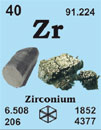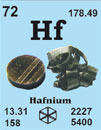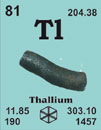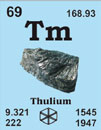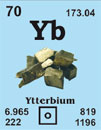& Kristalle GmbH

-
 English
English
-
 Deutsch
Deutsch
No products
Prices are tax excluded
Lanthanum (La)
We are a leading manufacturer and supplier of research materials
Lanthanum 57La138.905
Discovered in 1839 by C.G. Mosander at Stockholm, Schweden.
[Greek, lanthanein = to lie hidden]
French: lanthane
German: Lanthan
Italian: lantanio
Spanish: lantano
Description: Lanthanum is a soft, silvery-white metal that rapidly tarnishes in air and burns easily if ignited. It reacts with water to give hydrogen gas. Lanthanum is used in optical glass and for flints. Lantahnum (III) salts are used as biological tracers for calcium.
Further Materials properties
| Crystal structure: |
(cell dimensions/pm), space group, |
|---|---|
| X-ray diffractions mass absorption coefficients: | CuKa 341 (µ/r) / cm2g-1 MoKa 45.8 (µ/r) / cm2g-1 |
| Neutron scattering length: | 0.824 b/10-12 cm |
| Thermal neutron capture cross-section: | 8.98 sa / barns |
| Density: | 6145 kg/m-3 [298 K] |
| Melting point: | 920.85°C / 1194°K |
| Boiling point: | 3456.85°C / 3730°K |
| Molar volume: | 22.60 cm3 |
| Thermal conductivity: | 13.5 [300 K] W m-1K-1 |
| Coefficient of linear thermal expansion: | 4.9 x 10-6 K-1 |
| Electrical resistivity: | 57 x 10-8 [298 K] Ωm |
| Mass magnetic susceptibility: | +1.1 x 10-8(s) kg-1m3 |
| Radi: | La3+ 122; atomic 188; covalent 169 |
| Electronegativity: | 1.10 (Pauling); 1.08 (Allred); 3.1 eV (absolute) |
| Effective nuclear charge: | 2.85 (Slater); 9.31 (Clementi); 10.43 (Froese-Fischer) |
| Number of Isotopes (incl. nuclear isomers): | 26 |
| Isotope mass range: | 125-> 149 |
Biological data
| Biological role: | None. |
|---|---|
| Toxicity | |
| Toxic intake: | n.a. |
| Lethal intake: | LD50 (chlorine, oral, rat) = 4200 mg Kg-1 |
| Hazards: | Lanthanum is mildly toxic by ingestion, and causes liver injury |
| Level in humans | |
| Blood: | n.a. mg dm-3 |
| Bone: | < 0.08 ppm |
| Liver: | 0.3 ppm |
| Muscle: | 0.0004 ppm |
| Daily dietary intake: | n.a. but very low |
| Total mass of element in average [70 kg] person: |
c. 0.8 mg |
Geological data
| Minerals: | Minerals are very rare. Iodine cycles through the environment, and rain water contains about 0.7 p.p.b. | |||
|---|---|---|---|---|
| Mineral | Formula | Density | Hardness | Crystal apperance |
| Allanite | Ca(Ce,La)(Al,Fe)3(SiO4)3OH | 4.0 | 5.5 - 6.0 | mon., sub-met. black |
| Bastnäsite-La* | (La,Ce,etc.)CO3(F,OH) | n.a. | n.a. | hex. |
| Cerite | (Ce,La,Ca)9(Mg,Fe)Si7(O,OH,F)28 | 4.75 | 5 | rhom., res. black |
| Monazite-La | (La, Ce, Nd, Th, etc.)PO4 | 5.20 | 5 - 5.5 | mon., waxy/vit. yellow-brown |
* Varieties of these minerals that are particularly rich in lanthanum.
| Chief ores: | monazite, bastnäsite |
|---|---|
| World production: | 12 500 tonnes/year |
| Producing areas: | USA, Brazil, India, Sri Lanka, Australia |
| Reserves: | c. 6 x 106 tonnes |
| Specimen: | available as chips, ingots or powder. Care! |
| Abundances | |
|---|---|
| Sun: | 13.5 (relative to H = 1 x 1012) |
| Earth's crust: | 32 ppm |
| Seawater | |
| Atlantic surface: | 1.8 x 10-6 ppm |
| Atlantic deep: | 3.8 x 10-6 ppm |
| Pacific surface: | 2.6 x 10-6 ppm |
| Pacific deep: | 6.9 x 10-6 ppm |
| Residence time: | 200 years |
| Classification: | recycled |
| Oxidation state: | III |
Source: Emsley, J. (1998) The Elements (3rd Edition)
Other sizes and specifications on request
Overview of elements with access to our shop
Fax: +49 (0) 2461 - 9352 - 11








































